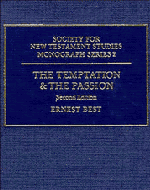Book contents
- Frontmatter
- Contents
- Preface to the First Edition
- Preface to the Second Edition
- List of Abbreviations
- PART I THE TEMPTATION
- PART II THE PASSION
- III The Markan Seams
- IV The Selection of the Material
- V The Order of the Material
- VI The Witness of Jesus and Others to Himself
- VII The Titles of Jesus
- VIII The Christian Community
- IX Conclusion
- Bibliography
- Index of Authors
- Index of Subjects
- Index of Passages Quoted
- Index of Greek Words
IX - Conclusion
from PART II - THE PASSION
Published online by Cambridge University Press: 28 October 2009
- Frontmatter
- Contents
- Preface to the First Edition
- Preface to the Second Edition
- List of Abbreviations
- PART I THE TEMPTATION
- PART II THE PASSION
- III The Markan Seams
- IV The Selection of the Material
- V The Order of the Material
- VI The Witness of Jesus and Others to Himself
- VII The Titles of Jesus
- VIII The Christian Community
- IX Conclusion
- Bibliography
- Index of Authors
- Index of Subjects
- Index of Passages Quoted
- Index of Greek Words
Summary
For Mark the Devil is defeated so far as the life of Jesus is concerned at the Temptation; in this conclusive contest Satan is bound and Jesus is thereafter able to reduce to obedience evilspiritual powers, the demons which possess men and evilcosmic forces met in sea storms. This encounter with the Devil in the Temptation is the decisive meeting of the forces of light and darkness, of order and chaos, of good and evil; this struggle which lay behind so much of the Old Testament and of the religion of the Near East of the period has now had its issue. But all the evil in the world is not seen by Mark as due to the Devil. In particular sin may arise from the tempting power of the Devil, but also from the seductive power of wealth, from the fear of persecution, from the enticements of other men and women, and from a man's own inner weakness in that he is flesh and not Spirit. Undoubtedly later Christian thought regarded the Devil as responsible for all temptation, but we are no more correct in reading such a view back into Mark than we are in reading it back into the Old Testament. How then is this other sin in men dealt with?
In the first place Mark views Jesus as the authoritative teacher who brings men to an understanding of the truth. This truth is known in the Church but is veiled from the eyes of those outside. Yet Jesus is not just a Gnostic revealer who gives insight to the initiated.
- Type
- Chapter
- Information
- The Temptation and the PassionThe Markan Soteriology, pp. 190 - 191Publisher: Cambridge University PressPrint publication year: 1990



